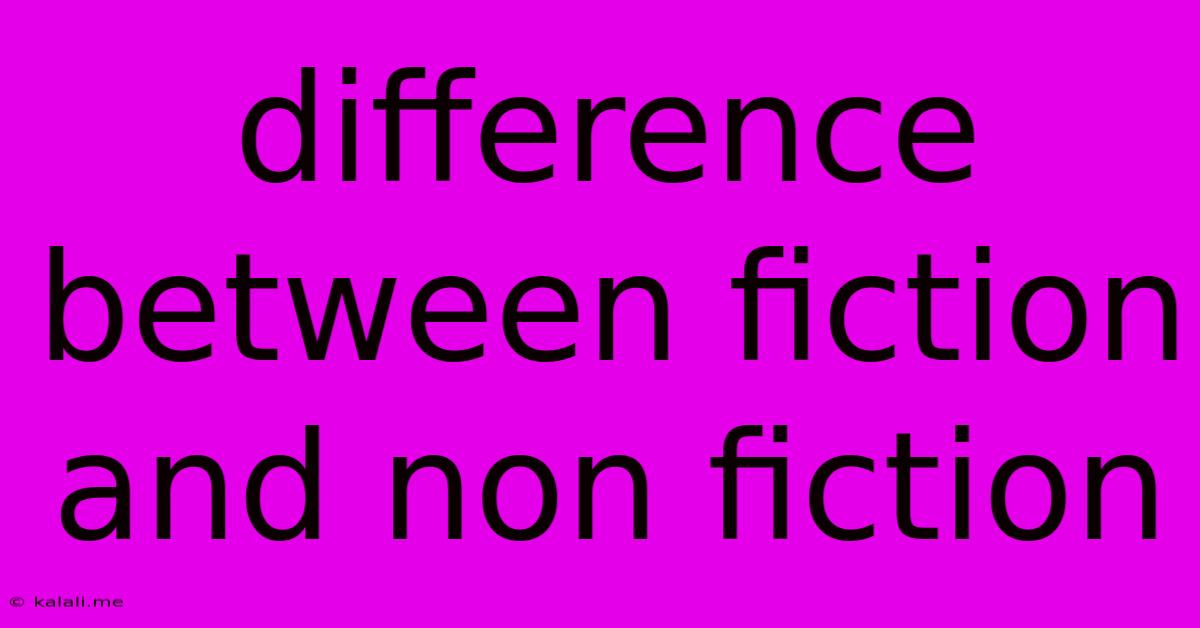Difference Between Fiction And Non Fiction
Kalali
Jun 11, 2025 · 3 min read

Table of Contents
Fiction vs. Nonfiction: Unveiling the Differences
The world of literature is broadly divided into two major categories: fiction and nonfiction. While seemingly straightforward, the distinction between these genres can sometimes be blurry, especially with the rise of creative nonfiction. This article will delve into the core differences between fiction and nonfiction, exploring their defining characteristics, purposes, and examples. Understanding these differences is crucial for both readers and writers navigating the literary landscape.
What is Fiction?
Fiction, at its core, is narrative writing that stems from the imagination of the author. It is not bound by the constraints of reality and can explore fantastical realms, imaginary characters, and invented events. The primary goal of fiction is to entertain, evoke emotions, and explore themes through a crafted narrative.
Key Characteristics of Fiction:
- Invented characters and plot: The characters and storyline are products of the author's imagination.
- Creative license: Authors can bend or break the rules of reality to achieve their artistic goals.
- Focus on storytelling: The emphasis is on creating a compelling and engaging narrative, often with a clear beginning, middle, and end.
- Exploration of themes: Fiction often serves as a vehicle for exploring universal themes such as love, loss, justice, and redemption.
- Subgenres: Fiction encompasses a wide range of subgenres, including novels, short stories, novellas, fables, myths, and fantasy.
Examples of Fiction:
- Novels: To Kill a Mockingbird by Harper Lee, 1984 by George Orwell, Pride and Prejudice by Jane Austen.
- Short Stories: Works by Edgar Allan Poe, Anton Chekhov, and Ernest Hemingway.
- Fantasy: The Lord of the Rings by J.R.R. Tolkien, Harry Potter series by J.K. Rowling.
- Science Fiction: Dune by Frank Herbert, The Martian by Andy Weir.
What is Nonfiction?
Nonfiction, in contrast to fiction, deals with factual information and real-world events. It aims to inform, educate, persuade, or inspire the reader based on verifiable evidence and accurate reporting. While it can employ narrative techniques to engage the reader, the foundation remains rooted in truth.
Key Characteristics of Nonfiction:
- Real people, places, and events: The subjects of nonfiction are based on reality, although the author's interpretation and perspective may shape the narrative.
- Emphasis on accuracy: Factual accuracy and proper attribution of sources are crucial for maintaining credibility.
- Informative and educational: The primary purpose is to provide factual information, often with supporting evidence.
- Various forms: Nonfiction encompasses a broad range of forms including biographies, autobiographies, essays, memoirs, documentaries, historical accounts, and journalistic reports.
- Subjectivity and objectivity: While aiming for objectivity, nonfiction can still reflect the author's perspective and interpretation of events.
Examples of Nonfiction:
- Biographies: Einstein: His Life and Universe by Walter Isaacson, Steve Jobs by Walter Isaacson.
- Autobiographies: Becoming by Michelle Obama, Long Walk to Freedom by Nelson Mandela.
- Essays: Works by Ralph Waldo Emerson, Joan Didion, and David Foster Wallace.
- Historical Accounts: Sapiens: A Brief History of Humankind by Yuval Noah Harari.
- Journalistic Reports: Investigative journalism pieces and news articles.
The Blurred Lines: Creative Nonfiction
Creative nonfiction blends the techniques of fiction writing with the factual basis of nonfiction. It uses literary devices like narrative structure, vivid descriptions, and character development to engage the reader while maintaining factual accuracy. Memoirs and personal essays often fall under this category.
Conclusion:
While the distinction between fiction and nonfiction is generally clear, understanding the nuances of each genre is essential for appreciating the richness and diversity of literature. Both forms serve important purposes, offering unique avenues for exploring the human experience, expressing creativity, and disseminating knowledge. Recognizing the core differences empowers readers to engage more meaningfully with the texts they encounter and writers to craft compelling and effective narratives.
Latest Posts
Latest Posts
-
University Of Alabama Average Sat Score
Jun 12, 2025
-
How Many Different Ways Are There To Save A Document
Jun 12, 2025
-
Which Pattern Should Replace The Question Mark In Column 4
Jun 12, 2025
-
Which Element Has The Highest Electronegativity
Jun 12, 2025
-
What Is The Opposite Of Dawn
Jun 12, 2025
Related Post
Thank you for visiting our website which covers about Difference Between Fiction And Non Fiction . We hope the information provided has been useful to you. Feel free to contact us if you have any questions or need further assistance. See you next time and don't miss to bookmark.